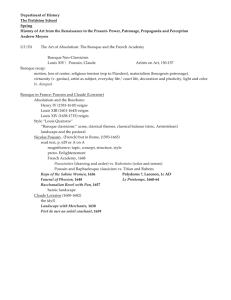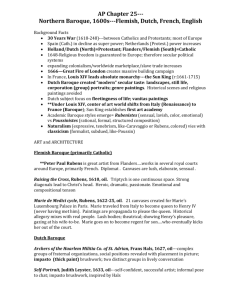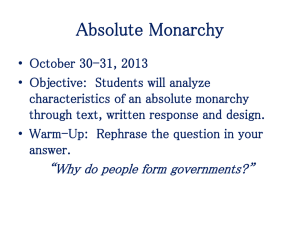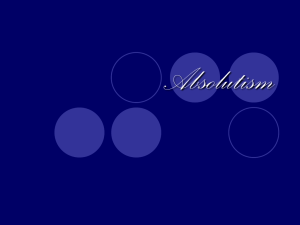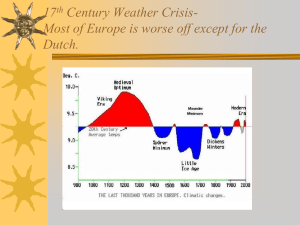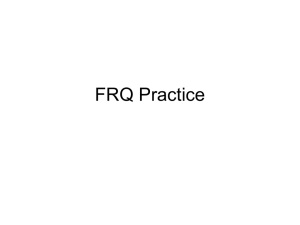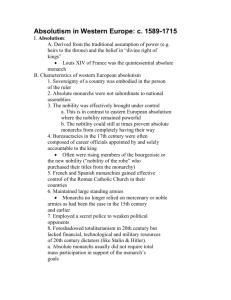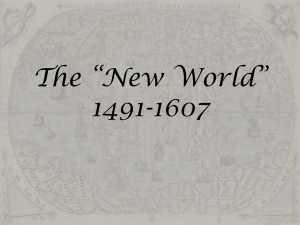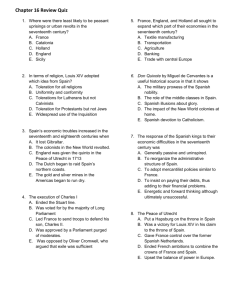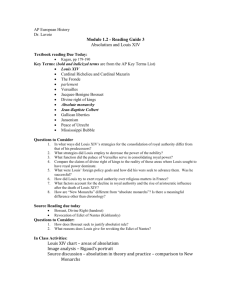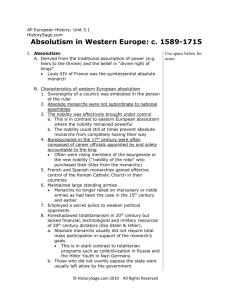Review #5 ABSOLUTISM IN WESTERN EUROPE: 1589
advertisement
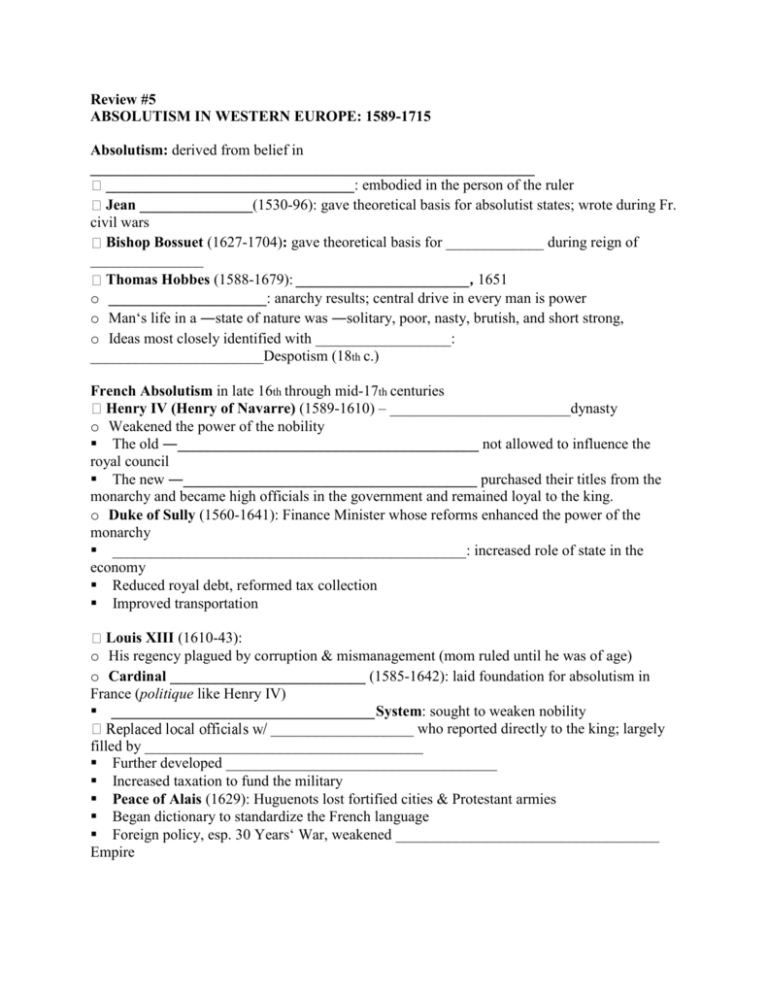
Review #5 ABSOLUTISM IN WESTERN EUROPE: 1589-1715 Absolutism: derived from belief in ___________________________________________________________ _________________________________: embodied in the person of the ruler Jean _______________(1530-96): gave theoretical basis for absolutist states; wrote during Fr. civil wars Bishop Bossuet (1627-1704): gave theoretical basis for _____________ during reign of _______________ Thomas Hobbes (1588-1679): _______________________, 1651 o _____________________: anarchy results; central drive in every man is power o Man‘s life in a ―state of nature was ―solitary, poor, nasty, brutish, and short strong, o Ideas most closely identified with __________________: _______________________Despotism (18th c.) French Absolutism in late 16th through mid-17th centuries Henry IV (Henry of Navarre) (1589-1610) – ________________________dynasty o Weakened the power of the nobility The old ―________________________________________ not allowed to influence the royal council The new ―_______________________________________ purchased their titles from the monarchy and became high officials in the government and remained loyal to the king. o Duke of Sully (1560-1641): Finance Minister whose reforms enhanced the power of the monarchy _______________________________________________: increased role of state in the economy Reduced royal debt, reformed tax collection Improved transportation Louis XIII (1610-43): o His regency plagued by corruption & mismanagement (mom ruled until he was of age) o Cardinal __________________________ (1585-1642): laid foundation for absolutism in France (politique like Henry IV) ___________________________________System: sought to weaken nobility ___________________ who reported directly to the king; largely filled by _____________________________________ Further developed ____________________________________ Increased taxation to fund the military Peace of Alais (1629): Huguenots lost fortified cities & Protestant armies Began dictionary to standardize the French language Foreign policy, esp. 30 Years‘ War, weakened ___________________________________ Empire Louis XIV (r. 1643-1715) – the ―Sun King quintessential model of absolutism in Europe o L’état, c’est moi (_______________________________________) o France became the undisputed power in Europe during his reign France had largest population in Europe (17 million); 20% of Europe‘s population o French culture dominated Europe French language became the international language of ___________________________(like English is today) and the language of the well-educated (like Latin in the Middle Ages) France remained the epicenter of _______________________________ until the 20th century _________________________________________ in art most evident in the works of Nicholas Poussin (1593-1665) French drama became extremely influential Moliere Jean Baptiste Racine Cardinal Jules Mazarin (1602-1661) : controlled France while Louis XIV a child o ________________________________________: failed revolution by nobility directed against Mazarin; inspired Louis later _______________________________________________ _________________________system continued to increase the power of the king at the expense of the old nobles. Versailles Palace: grandest and most impressive palace in Europe o In effect, became a pleasure prison for the French nobility, over which Louis gained control o Cost of maintaining the palace: _____________% of all royal revenues! o Louis considered himself the head of the ____________________Church and thus did not allow _____________________ to exercise political power in France o Edict of Fountainbleau (1685): revoked the ___________________________, thus ending religious toleration for Huguenots o Repressed Jansenism (a kind of _________________________within Catholic Church) Mercantilism brought to its apex by Jean-Baptiste ___________________ (1661-1683) o State control _________________________________________________in order to achieve a favorable _____________________________________________ with other countries. o Colbert‘s goal was economic self-sufficiency for France Promoted ―____________________________: a nation‘s policy of accumulating as much precious metal (gold and silver) as possible while preventing its outward flow to other countries. Built _______________________ & ________________________; gov‘t supported monopolies; cracked down on guilds; reduced local tolls and tariffs; organized French trading companies for international trade: _____________________ and the ______________________. Most important accomplishment: developed the ____________________________________ o By 1683, France leading industrial country: ________________, __________________, lace making, foundries for_______________ making and ____________________ o Weaknesses: Poor peasant conditions (esp. taxation) resulted in __________________________________ Louis opted for army instead of______________; France later lost naval wars w/ England War in later years nullified Colbert‘s gains; Louis at war for _______________ of his reign Wars of Louis XIV: initially ___________________ but eventually ____________ to France o A system of _____________________________________ developed to keep France in check William of ____________ (later, King William III of England) thwarted Louis‘ expansionism o War of Devolution (First Dutch War), 1667-68: France gained 12 fortified towns along the French-Belgian border but gave up Burgundy in return. o Second Dutch War (1672-78) – Invasion of the Dutch Rhineland France took Franche-Comté from Spain, gained some Flemish towns, and took ___________ Represented the furthest extent of Louis XIV‘s expansion War of the League of Augsburg (1688-97): eventually ended in status quo o League of Augsburg (formed in 1686 to counter France‘s growing power): included the ___________________, Spain, _______________, Bavaria, _______________, Dutch Republic o William of Orange (now king of England) brought England in against France. War of Spanish Succession (1701-13) o The will of Charles II (Spanish ___________________king) gave all Spanish territories to grandson of _______________________; other countries feared France would dominate o ______________________________ sought to preserve the balance of power: England, Dutch Rep., HRE, Brandenburg, Portugal, Savoy o Treaty of______________ (1713): most important treaty since __________________(in 1648) Britain was biggest winner: gained the _______________ (slave trade) from Spain; gained Gibraltar and Minorca. Spanish Netherlands (Belgium) was given to ___________(became the Austrian Netherland) Although Louis XIV‘s grandson enthroned, the treaty prevented the unification of Bourbon dynasties. Kings recognized in Sardinia (Savoy) and Prussia (Brandenburg) o Destroyed France‘s economy o _____________% of French subjects died o Huge debt placed on the _____________Estate French gov‘t was__________________ o Financial and social tensions sowed the seeds of the _________________________________ Decline of the Spanish Empire (although it remained most powerful military until mid-17th c.) _________________________ in Spain was laid by Charles V (1519-1556) and Philip II (1556-1598) Spanish dominance s of middle class: _________________ and _______________ had been expelled in large numbers (Spain‘s population declined by over ______________%) trade with its colonies fell __________% between 1610 and 1660 ___________________ nflation from the _______________hurt domestic industries that were unable to export goods ______________) Religion _________________________________ politics in domestic affairs ______________________ War: politically and economically disastrous Treaty of the ___________________________(1659): marked end of Spain as a Great Power o Spain lost parts of Spanish Netherlands and territory in northern Spain to France Population in 1660 had declined to 5.5 million from 7.5 million in 1550 _________________________(1713) The Baroque ______________________________________ countries to teach in a __________________ and __________________way and demonstrate the glory and ______________of the Catholic Church o Style later spread to Protestant countries (Netherlands, northern Germany and England) o Sought to ________________________ the viewer: emphasized grandeur, emotion, movement, spaciousness, and unity surrounding a certain theme o ______________________________(1598-1650) Colonnade for piazza in front of ______________________________ in Rome was his greatest architectural achievement. Sculpted the Canopy over the high altar of St. Peter’s Cathedral His altarpiece sculpture, _______________________________, evokes tremendous emotion His statue of ________________________________shows movement and emotion o Characteristics Stressed broad areas of ___________ and __________________rather than on linear arrangements of the High Renaissance. Color was an important element as it appealed to _______________ and more true to nature. Not concerned with clarity of detail as with overall _________________________________. Designed to give a spontaneous personal experience. o ________________________ (1571-1610), Roman painter, perhaps 1st important painter of the Baroque era Depicted highly emotional scenes Used sharp contrasts of light and dark to create drama. o Peter Paul ____________________________________ (1577-1640), Flemish painter Worked for the ________________ court in Brussels (the capital of the Spanish Netherlands) Emphasized color and sensuality; animated figures and melodramatic contrasts; monumental size. Nearly __________________of his works dealt with _________________________subjects. o Diego ______________________________(1599-1660) Perhaps the greatest ___________________ painter of the era Numerous portraits of the Spanish court and their surroundings o Artemisia ______________________(1593-1652) Famous for vivid depictions of dramatic scenes and her Judith paintings th century, the Baroque reflected the Age of _________________________________ o ________________________Palace typifies Baroque architecture Hapsburg emperor Leopold I built _______________________ in Austria in response to the Versailles Palace Peter the Great in Russia built the ____________________________ in St. Petersburg largely on the influence of Versailles Frederick I in Prussia began building his palace in _________________________in 1701 o Characteristics Belief that the text should dominate the music; the__________________________________ __________________________________________were most important Baroque composers developed the modern system of major-minor tonalities. Dissonance was used much more freely than during the Renaissance o Claudio_____________________ (1547-1643) developed the opera and the modern orchestra o J. S. ___________________(1685-1750): greatest of the ____________________ composers Often wrote dense and polyphonic structures (in contrast to the later balance and restraint of the Classical Period—Mozart & Haydn) Wrote in a variety of genres, both choral and instrumental, for a variety of instruments o George Frideric ____________________________________ (1685-1759) Like Bach, wrote in a variety of genres His masterpiece is the oratorio __________________________________________________ The Dutch Style: 17th century painting o Did not fit the Baroque style of trying to overwhelm the viewer o Reflected the Dutch Republic‘s wealth and _________________________ of secular subjects o Reflected the ______________and _____________________settings of Dutch life during the Golden Age of the Netherlands o Many works were commissioned by merchants or government organizations ______________________van Rijn (1606-1669), painter o Perhaps the greatest of all Baroque artists _________________________________________ _______________________________________ category. o Scenes covered an enormous range throughout his career o Used extremes of light in the Baroque style o His works were far more intimate and ______________________than typical Baroque works o Painted with the restraint of the classicist style Jan __________________________________ (1632-1675) o Paintings of interior domestic settings of ordinary people in simple scenes Rococo style (in France) o Characteristics: elegance, pleasantness, ________________; contrasts ___________________ grandeur of Baroque



